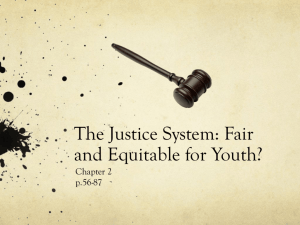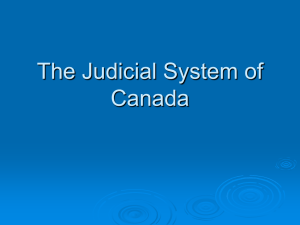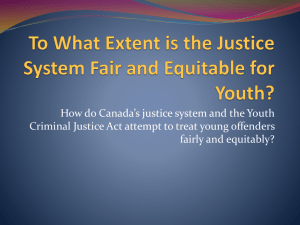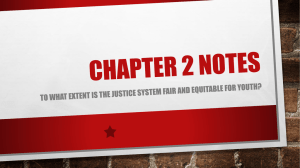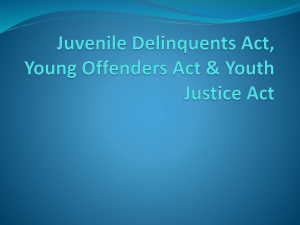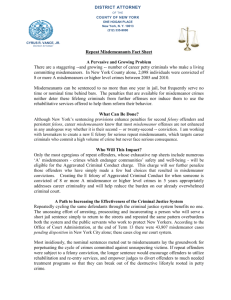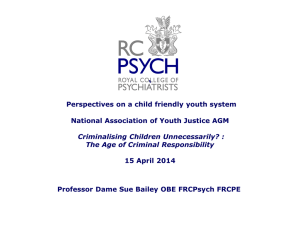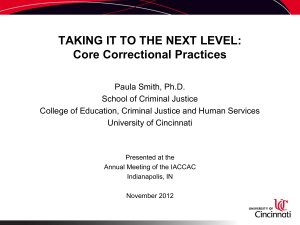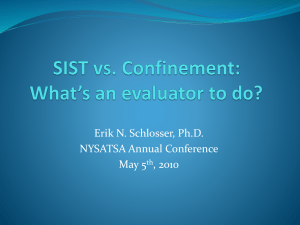Chapter 2
advertisement
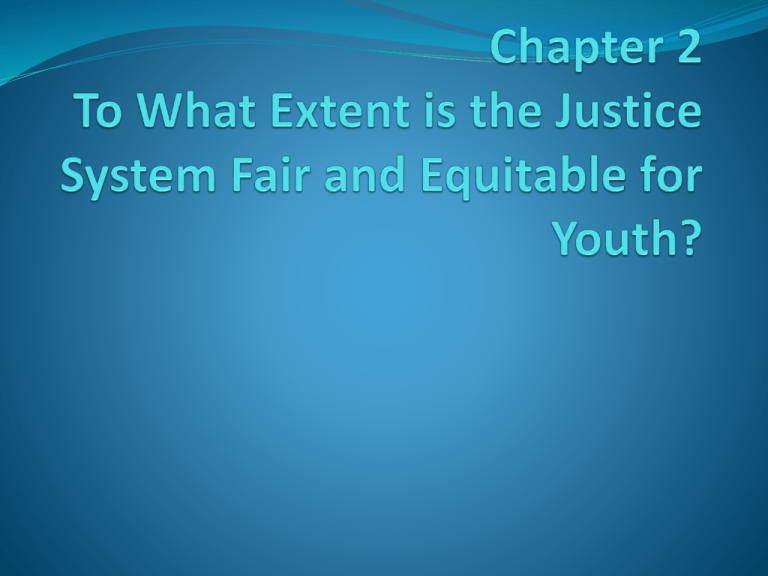
Terms Fair and Equitable Governed by rules that apply to everyone, taking into account individual needs and circumstances Justice Applying laws Justice System The institution and procedures for applying laws in a society Class Discussion Why is Justice often portrayed as blind? Pg 57 Read Beverly Mclauchlin’s remarks What challenges is she referring to? Do you agree with her statement “nothing is more important then justice”? Why or why not? What's to come- pg 60 What are we hoping to learn this chapter? What questions do I need to be able to answer? Read “inside the Justice System” comic What factors had the biggest impact on this young offenders change of attitude? What life lessons can we learn from her story? How are Youth and Adult Justice Different in Canada? Canada has different legislation for youth and adults who break the law Youth Criminal Justice Act Criminal Code of Canada Young Offenders Adult Offenders Youth Criminal Justice Act Deals with 12-17 year olds in trouble with the law Allows some young offenders to face consequences such as counseling and community service Prohibits adult sentencing for 12-14 year olds. Allows adult sentencing for young people 14 and up who have committed serious crimes Protects the privacy of young offenders News media cannot publish names unless they receive and adult sentence Allows most young offenders to avoid a criminal record Criminal Code of Canada Deals with adults in trouble with the law Makes going to court the usual consequence Defines adult sentences, which can include periods of imprisonment for some crimes Allows the publication of the offenders name Creates a criminal record Time to think….. How might a criminal record affect your quality of life? Flow Chart- Pg 66 What are the consequences if you break the law as a young offender? Before the YCJA, every young person who broke the law charged and went to court. This meant that often: Young offenders did not face consequences for a long time as courts are very busy The consequences did not always connect back to the communities affected Factors that Determine Consequences for Young Offenders Lets read and summarize pg. 68 Objectives of the YCJA 1. Prevent crime by addressing the circumstances underlying young persons offending behavior Ex. ????? 2. Rehabilitate young offenders and reintegrate them into society Ex. ?? 3. ensure that the young person is subject to meaningful consequences for the offence in order to promote long term protection of society Ex. ????? 4. The YCJA must recognize that young people are separate from adults and have reduced levels of maturity Ex. ???? Is it Working? Analyze the graph on pg 71 Based on your knowledge and the graph, do you think that the number of crimes committed by youth in this country has been reduced because of the YCJA? Complete objectives of the YCJA worksheet Political Cartoons Political cartoons convey an opinion about a topic. They are a type of persuasive communication Cartoons have to be analyzed to understand their message. Political Cartoon worksheet What Role do Citizens and Organizations Play in the fairness and equity of Canada's Justice System for Youth? Responsibilities of a Juror Under the YCJA, a person under the age of 14 may choose to tried by a judge and jury for certain serious crimes For these offences, juries must have 12 people and all 12 must agree on a verdict Anyone 18 yrs of age and older and is a Canadian citizen is eligible for jury duty with some exceptions what might these exceptions be? Jury duty is considered a duty 0f Canadian citizens If you are summoned, you must make any and all arrangement to be at the courthouse Employers must give you time off You can be excused if you can prove it will cause you hardship Its important to remember that a jury does not have to come to a verdict that the judge or members of the public must agree with They must remain impartial, regardless of the issue Jury selection is a very important part of the justice process. Both sides of a case must agree on who will part of the jury. Ex. Member of KKK as a member of the OJ Simpson trial Juror terms These terms can be found on pg 79. read, summarize, and put into your notes Defense Prosecution Sequester Justice Advocacy Groups These organizations work independently from the government. They try to solve the underlying reasons for crime They Provide public education about the YCJA and the Criminal Code of Canada They help people who have broken the law return to their communities They stand up for the rights of youths and adults accused of crimes John Howard Society Works with men, women, boys, and girls in trouble with the law What does Brad Olsen have to say about the importance of the John Howard Society?- pg 82 Read handout and answer questions Elizabeth Fry Society Focuses on justice issues for women and girls What does Jacqueline Biollo have to say about the society and its role? To what extent do both societies agree on what goals the justice system should have? The Role of Elders Sometimes the fate of a youth can be decided by a committee of elders- people in the community who are older and respected. An elder is someone that the youth in that community should look up to and strive to be like. Chapter 2 Assignment YCJA Multimedia Presentation
